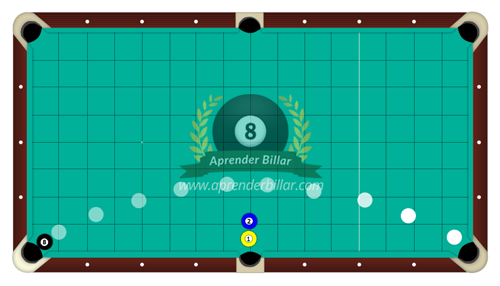
The Ultimate Guide to Buying The Best Pool Cue Stick
🎱 Talking to pool pro’s, I wrote the best tips for buying the best pool cues the smart way so you can choose your professional pool cue.

A massé shot, also called a curve shot, is a shot in which the cue stick is elevated to give the cue ball a significant amount of side and bottom spin, which causes the cue ball’s trajectory to curve.
Elevating the cue imparts significant spin without giving too much speed to the cue ball.
The combination of side spin and slow forward motion allows the cue ball to curve quite dramatically.
There are several different positions and bridges you can use to achieve billiard cue movement.
With each method, the stability of the bridge is the key.
The high V-bridge technique involves a highly elevated open bridge; it is comfortable because it is familiar to most people.

There is no direct path to the 1-ball and no reasonable shot opportunity. Instead, a massé shot is used to curve the cue ball trajectory around the obstacle, the 4-ball.
To execute the shot, the cue must be elevated and the cue ball is hit from above, with english from the bottom left.

🎱 Talking to pool pro’s, I wrote the best tips for buying the best pool cues the smart way so you can choose your professional pool cue.
Let’s explain it better.
A massé shot is when you curve the ball, so that means that instead of the ball going in a straight line, it will curve. It’s probably one of the most difficult shots in billiards, you’re going to use spin, left and right, and you’re going to combine all of that.
So, the only difference between the massé and a normal spin is that with a normal shot you have the cue parallel to the table, as much as possible.
For a massé you’re going to raise your cue more than 45 degrees usually. So this is a very typical situation, for example.
Look at the picture above, if the cue ball is here, and you have to make the 1-ball because I played the wrong position or my opponent played a safety. I can’t make bands here. I can’t really go two or three-ball, I mean it’s quite difficult.
So, the easiest way would be to do it using massé. I’m going to try to hit the cue ball around the 4-ball and pocket the 1-ball. And that’s how you get out of a very difficult situation and that’s how you win the game.
Now let’s take the cue ball, and think of it as a clock, but instead of hitting it from the side.
Let’s hit it from the top. Raise your pool cue. You can raise it from 45 to 90 degrees depending on how far you want to go and how much of a curve you want to get.

Hit the top of the cue ball at 9 o’clock to make a massé to the left and 3 o’clock for a massé to the right and 6 o’clock to go straight back.
Then we’re going to hit 6 o’clock first. Basically it’s going to come straight back to me. I’m going to do the same thing, I’m going to hit 9 o’clock, and you see that the ball goes totally on the left side. Now let’s do the exact same thing, but at 3 o’clock, it’s going to go to the right side. And now you can combine all of that.
Let’s say you want to hit the 7 o’clock, so let’s hit it here to the left side.
Using a combination of massé shot effects.
We aim at the 7 o’clock position, the cue ball spins back and to the left. And the ball comes back to you, with a little bit of left.

So of course it looks that easy, but it’s very difficult to judge a massé, because it’s going to depend on the table. How much it slides, and it’s going to be harder if the balls are clean or dirty.
But this can really save you from some desperate situations.
Not all massé shots are so vertical. Sometimes you have to do what I call a “semi-massé.”
Let’s say I’m here and I want to pocket the 8-ball, which is in the corner. And I have this ball blocking it. I can try to use a rail, but maybe some object balls will block me. Still, it’s still a pretty tough shot, but you can do what I call a semi-massé.

Hitting the cue ball at 45 degrees with english to the left or to the right will gently bend the cue ball on the trajectory. This shot is significantly easier than executing a full massé.
So raise your cue about 45 degrees and hit the ball with lots of spin to the left. And again, this can save you from a desperate situation.
Take some practice shots, but I really can’t advise you to do this in a billiard room. If you do, try to protect the table.
Practicing these shots can leave some pretty bad marks, especially if you aim at a steep angle and follow through to the cloth, which you’re going to cut.
You really don’t want to do that in any billiard room, so if you practice these shots, try to protect the table.
What I need to stress about the massé shot is that people always think you just hit the ball and don’t hit the cloth, but you actually hit the cloth when you make a massé shot.
If you take a look at a close-up, when you hit the ball, it will leave a white mark on the table.
This is a burn mark from the friction of the ball. If you look, you will also see the cue tip mark. You will then see the white spot along with the chalk mark from your cue tip.
If you make the shots at a good angle, you won’t make a hole and just leave a burn mark. But if you do it at a bad angle, you could cut the cloth, which is a very bad thing.
Massé takes practice, and is not advised if you are just a beginner. Once you get used to billiards and start getting serious, it is a very mandatory learning opportunity.
If you are an apprentice I recommend you go to the section to learn what it takes to be a great professional player.
Massé shots are very difficult, and sometimes it is easier to jump a ball.
A popular belief in billiards is that to skip a ball, you have to put your cue under the ball and lift it.
But that’s actually a foul, so you can never do that.
If you see someone doing that, inform them that they are doing it wrong.
Never do that, first of all if you aim down, what could happen is tear the cloth or leave a bad mark. It’s not good to do that, not even in pool halls where you might get noticed.
And secondly it is a foul, literally. In billiards, you can’t put your tip under the ball and lift it.
Finally, here is an exercise to help you learn how to execute massé correctly.

A small part of the information gathered was from PoolDawg and Florian Kholer “Venom”.
Question from Ramon.
Massé cues are generally shorter, heavier and stiffer, and usually have a larger shaft diameter and tip.
The shorter length is to improve handling and reduce clearance issues above the tip.
The additional strength and stiffness is for durability and better action.
The extra weight can also help you get more action with less effort.
Some people prefer a softer tip, but it will not take abuse as well as a stiffer tip.
However, with a harder tip, you need to make sure it is well shod (as with any tip) and holds chalk well to provide good contact with the ball.
A medium hard tip offers a good compromise of durability and reliability in chalk retention.
Most jump cues have a phenolic tip.
Massé cues use a leather tip because grip is still needed to impart all that effect.
Many massé cues have a larger tip (14 mm).
Some jump cues have it, but most stay around 13 mm.
I like the lighter massé cues, between 19 and 21 ounces.
There are players who use heavier 24-ounce cues on some shots.
And other players use their cues up to 30 ounces or more.
Jump cues tend to be between 6-10 oz.
Massé cues also tend to be a little longer than jump cues.
Most jump cues stay around 40 inches, I think mainly because of the weight issue.
Massé cues tend to be between 46 and 52 inches (though don’t take these figures as fixed stops).